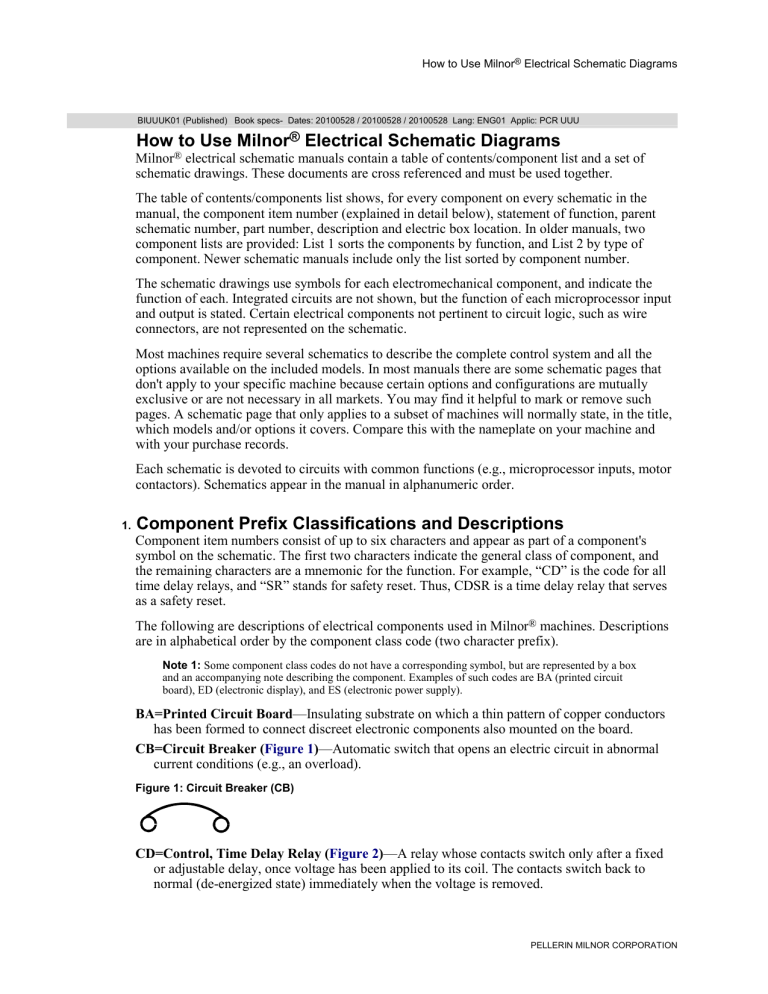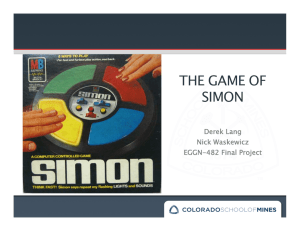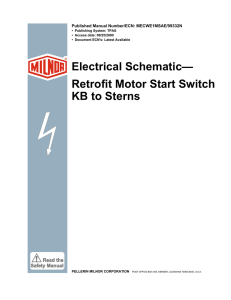How to Use Milnor® Electrical Schematic Diagrams

How to Use Milnor ® Electrical Schematic Diagrams
BIUUUK01 (Published) Book specs- Dates: 20100528 / 20100528 / 20100528 Lang: ENG01 Applic: PCR UUU
How to Use Milnor
®
Electrical Schematic Diagrams
Milnor ® electrical schematic manuals contain a table of contents/component list and a set of schematic drawings. These documents are cross referenced and must be used together.
The table of contents/components list shows, for every component on every schematic in the manual, the component item number (explained in detail below), statement of function, parent schematic number, part number, description and electric box location. In older manuals, two component lists are provided: List 1 sorts the components by function, and List 2 by type of component. Newer schematic manuals include only the list sorted by component number.
The schematic drawings use symbols for each electromechanical component, and indicate the function of each. Integrated circuits are not shown, but the function of each microprocessor input and output is stated. Certain electrical components not pertinent to circuit logic, such as wire connectors, are not represented on the schematic.
Most machines require several schematics to describe the complete control system and all the options available on the included models. In most manuals there are some schematic pages that don't apply to your specific machine because certain options and configurations are mutually exclusive or are not necessary in all markets. You may find it helpful to mark or remove such pages. A schematic page that only applies to a subset of machines will normally state, in the title, which models and/or options it covers. Compare this with the nameplate on your machine and with your purchase records.
Each schematic is devoted to circuits with common functions (e.g., microprocessor inputs, motor contactors). Schematics appear in the manual in alphanumeric order.
1.
Component Prefix Classifications and Descriptions
Component item numbers consist of up to six characters and appear as part of a component's symbol on the schematic. The first two characters indicate the general class of component, and the remaining characters are a mnemonic for the function. For example, “CD” is the code for all time delay relays, and “SR” stands for safety reset. Thus, CDSR is a time delay relay that serves as a safety reset.
The following are descriptions of electrical components used in Milnor ® machines. Descriptions are in alphabetical order by the component class code (two character prefix).
Note 1: Some component class codes do not have a corresponding symbol, but are represented by a box and an accompanying note describing the component. Examples of such codes are BA (printed circuit board), ED (electronic display), and ES (electronic power supply).
BA=Printed Circuit Board—Insulating substrate on which a thin pattern of copper conductors has been formed to connect discreet electronic components also mounted on the board.
CB=Circuit Breaker ( Figure 1 )—Automatic switch that opens an electric circuit in abnormal current conditions (e.g., an overload).
Figure 1: Circuit Breaker (CB)
CD=Control, Time Delay Relay ( Figure 2 )—A relay whose contacts switch only after a fixed or adjustable delay, once voltage has been applied to its coil. The contacts switch back to normal (de-energized state) immediately when the voltage is removed.
PELLERIN MILNOR CORPORATION
How to Use Milnor ® Electrical Schematic Diagrams
Figure 2: Time Delay Relay (CD)
Coil and Contacts Legend
A. Coil
B. Contacts
.
CL=Control, Latch Relay ( Figure 3 )—A relay which latches in an energized or set position when operated by one coil (the latch/set coil). The relay stays latched even though coil voltage is removed. The relay releases or unlatches when voltage is applied to a second coil (the unlatch/reset coil).
Figure 3: Latch Relay (CL)
Coils and Contacts Legend
A. Coils
B. Contacts
.
CR=Control, Relay ( Figure 4 )—A relay whose contacts switch immediately when voltage is applied to its coil and revert to normal when the voltage is removed.
Figure 4: Standard Relay (CR)
Coils and Contacts Legend
A. Coil
B. Contacts
.
CP=Control, Photo-Eye ( Figure 5 )—Photo-eyes sense the presence of an object without direct physical contact. Photo-eyes consist of a transmitter, receiver, and output module. These components may be housed in one assembly with the transmitter bouncing light off of a reflector to the receiver, or these components can be housed in two separate assemblies with the transmitter pointed directly at the receiver. The photo-eye can be set to turn on its output either when the light beam becomes blocked (dark operate) or when it becomes un-blocked
(light operate).
PELLERIN MILNOR CORPORATION
Figure 5: Photo-eye (CP)
Symbols
How to Use Milnor ® Electrical Schematic Diagrams
Legend
A. Example of single assembly
B. Example of two separate assemblies
.
CS=Control, Contactor/Motor Starter ( Figure 6 )—A relay capable of handling heavier electrical loads, usually a motor.
Figure 6: Other Control Symbols
EB=Electric Buzzer ( Figure 6 )—An audible signaling device.
EC=Electric Clutch ( Figure 6 )—A clutch consists of a coil and a rotor. The rotor has two separate rotating plates. These plates are free to rotate independent of each other until the coil is energized. Once energized the two plates turn as one.
ED=Electronic Display—A visual presentation of data, such as an LCD (liquid crystal display),
LED (light emitting diode) display, or VFD (vacuum florescent display).
EF=Electric Fuse ( Figure 6 )—A fuse is an over-current safety device with a circuit opening fusible member which is heated and severed by the passage of over-current through it.
EL=Electric Light ( Figure 6 )—Indicator lights may be either incandescent or fluorescent.
EM=Electro Magnet Solenoid—A device consisting of a core surrounded by a wire coil through which an electric current is passed. While current is flowing, iron is attracted to the core (e.g., a pinch tube drain valve solenoid).
ES=Electronic Power Supply—A device that converts AC (alternating current) to filtered and regulated DC (direct current). The input voltage to the power supply is usually 120 or 240
VAC. The output is +5, +12, and -12 VDC.
ET=Thermal Overload ( Figure 7 )—A safety device designed to protect a motor. A thermal overload consists of an overload block, heaters, and an auxiliary contact. The auxiliary contact is normally installed in a safety (three-wire) circuit that stops power to the motor contactor coil when a motor overload occurs.
PELLERIN MILNOR CORPORATION
How to Use Milnor ® Electrical Schematic Diagrams
Figure 7: Thermal Overload (ET)
Schematic Symbol Legend
A. Heater (one per phase)
B. Overload relay; contacts open if overload condition exists
.
EX=Electrical Transformer ( Figure 8 )—A device that transfers electrical energy from one isolated circuit to another, often raising or lowering the voltage in the process.
KB=Keyboard—Device similar to a typewriter for making entries to a computer.
MN=Electronic Monitor (CRT)—A cathode ray tube used for visual presentation of data.
MR=Motors ( Figure 9 )—Electromechanical device that converts electrical energy into mechanical energy.
Figure 8: Transformer (EX) Figure 9: Electric Motor (MR)
MV=Motor (Variable Speed) Inverter—To vary the speed of an AC motor, the volts to frequency ratio must be kept constant. The motor will overheat if this ratio is not maintained.
The motor variable speed inverter converts three phase AC to DC. The inverter then uses this
DC voltage to generate AC at the proper voltage and frequency for the commanded speed.
Note 2: Switch symbols used in the schematics and described below always depict the switch in its unactuated state.
PX=Proximity Switch ( Figure 10 )—A device which reacts to the proximity of an target without physical contact or connection. The actuator or target causes a change in the inductance of the proximity switch which causes the switch to operate. Proximity switches can be two-wire
(AC) or three-wire (DC) devices.
PELLERIN MILNOR CORPORATION
Figure 10: Proximity Switches (PX)
Switch Symbols
How to Use Milnor ® Electrical Schematic Diagrams
Legend
A. Alternating current proximity switch
B. Direct current proximity switch
.
SC=Switch, Cam Operated ( Figure 11 )—A switch in which the electrical contacts are opened and/or closed by the mechanical action of a cam(s). Applications include 35-50 pound timer operated machines, Autospot, timer reversing motor assembly, and some balancing systems.
SH=Switch, Hand Operated ( Figure 12 )—A switch that is manually operated (e.g., Start
button, Master switch, etc.).
Figure 11: Cam Switch (SC) Figure 12: Hand Operated Switch
(SH)
SK=Switch, Key Lock ( Figure 13 )—A switch that requires a key to operate. This prevents unauthorized personnel from gaining access to certain functions (e.g., the Program menu).
SL=Switch, Level Operated ( Figure 14 )—A switch connected to a float that causes the switch to open and close as the level changes.
Figure 13: Key Switch (SK) Figure 14: Level Switch (SL)
SM=Switch, Mechanically Operated ( Figure 15 )—A switch that is mechanically operated by a part of or the motion of the machine (e.g., door closed switch, tilt limit switches, etc.)
SP=Switch, Pressure Operated ( Figure 16 )—A switch in which a diaphragm presses against a switch actuator.
PELLERIN MILNOR CORPORATION
How to Use Milnor ® Electrical Schematic Diagrams
Figure 15: Mechanical Switch (SM) Figure 16: Pressure Switch (SP)
ST=Switch, Temperature Operated ( Figure 17 )—A switch that is actuated at a preset temperature (e.g., dryer safety probes) or has adjustable set points (e.g., Motometers or
Combistats).
TB=Terminal Board ( Figure 18 )—A strip or block for attaching or terminating wires.
Figure 17: Temperature Switch
(ST)
Figure 18: Terminal Board (TB)
VE=Valve, Electric Operated ( Figure 19 )—A valve operated by an electric coil to control the flow of fluid. The fluid can be air, water or hydraulic.
Figure 19: Electrically Operated
Valve (VE)
ZF=Rectifier ( Figure 20 )—A solid state device that converts alternating current to direct current.
PELLERIN MILNOR CORPORATION
Figure 20: Bridge Rectifier (ZF)
Component Symbol
How to Use Milnor ® Electrical Schematic Diagrams
Legend
A. Alternating current input
B. Direct current output
.
Figure 21: Bridge Rectifier
Component Legend
A. Alternating current in
B. Negative direct current out
C. Positive direct current out
.
WC=Wiring Connector—A coupling device for joining two cables or connecting a cable to an electronic circuit or piece of equipment. Connectors are male or female, according to whether they plug into or receive the mating connector.
2.
Component Terminal Numbering
CAUTION 1 : Risk of Mis-wiring —Due to electrical component manufacturing inconsistencies, the pin numbers imprinted on components such as connectors and relay bases used on Milnor machines often do not correspond to the pin numbers shown in the schematics.
• Ignore pin numbers imprinted on in-line connectors (e.g., Molex connectors) and relay bases.
• Use the pin identification illustrations herein to identify pins on these components.
PELLERIN MILNOR CORPORATION
How to Use Milnor ® Electrical Schematic Diagrams
Figure 22: Plug-in Relays
11-pin Relay with Grey Base
14-pin Relay with Grey Base (older)
14-pin Relay with Black Base (newer)
Legend
Left. View of relay and base
.
Right. Same view, showing assigned pin numbers
Note 3: Relay functional names ending with the letter "M" (e.g., CRxxM) are not discrete components but are a component of a printed circuit board. They are usually not individually replaceable.
PELLERIN MILNOR CORPORATION
Figure 23: AMP Connector Pin Locations
How to Use Milnor
36-pin Connector
® Electrical Schematic Diagrams
18-pin Connector Legend
A. View of mating halves of connector
B. Same view, showing assigned pin numbers
.
PELLERIN MILNOR CORPORATION
How to Use Milnor ® Electrical Schematic Diagrams
Figure 24: Molex Connector Pin Locations
15-pin Connector 9-pin Connector
6-pin Connector 4-Pin Connector
2-pin Connector Legend
A. View of mating halves of connector
B. Same view, showing assigned pin numbers
.
PELLERIN MILNOR CORPORATION
How to Use Milnor ® Electrical Schematic Diagrams
Figure 25: Pressure Switch
Component Legend
A. Contact 1—Normally open
B. Contact 2—Normally closed
C. Contact 3—Common
.
Figure 26: Toggle Switch
Component Legend
A. Normally closed contacts
B. Common contacts
C. Normally open contacts
D. Pole
.
.
Figure 27: Switch with Replaceable Contact Blocks
Rotary or Push-button Switch Component Legend
A. Terminal 7
B. Terminal 8
C. Terminal 4 if normally open; terminal 1 if normally closed
D. Terminal 5 if normally open; terminal 2 if normally closed
E. Terminal V
F. Terminal 9
G. Terminal Q if normally open; terminal K if normally closed
H. Terminal 6 if normally open; terminal 3 if normally closed
I. Terminal W
J. Terminal X
K. Terminal R if normally open; terminal L if normally closed
L. Terminal S if normally open; terminal M if normally closed
3.
Features of Milnor
®
Electrical Schematic Diagrams
Document BMP010012 (following this section) is a sample schematic, based on a schematic diagram for the Milnor ® gas dryer. For the purposes of this exercise, the schematic is shown gray and explanations of the items on the schematic are shown black.
The item numbers below correspond to the circled item numbers shown on the drawing.
1. The first six characters of the drawing number (W6DRYG) indicate that this is a wiring diagram (W), identify the generation of controls (6), and identify the type of machine
(DRYG=Gas Dryer). These characters appear in the drawing number of every schematic in the set.
The characters following the first six are unique to each drawing. The two characters identified as the page number are an abbreviation for the function performed by the depicted
PELLERIN MILNOR CORPORATION
How to Use Milnor ® Electrical Schematic Diagrams circuitry (S+=three-wire circuit) and establish the order in which the schematic occurs in the manual (schematics are arranged in alpha-numeric order in the manual).
Whenever circuitry changes are significant enough to warrant publishing a new schematic drawing, the new drawing number will be the same as the old except for the major revision letter (A in the example).
2. Included in the drawing title are the class of control system, the title of this circuit, and the circuit voltage.
3. Line numbers are provided along the bottom edge of the drawing. These permit service personnel in the field and at the Milnor ® factory to quickly relate circuit locations when discussing troubleshooting over the phone. Page and line numbers are referenced on the drawing as explained in items five and six below.
4. Relay contacts show the page and line number on which the relay coil may be found. This is the type of cross referencing most frequently used in troubleshooting.
5. Relay coils show the page and line number on which its associated contacts are located.
6. Relay contacts and relay coils show the physical location of the relay.
7. The designation MTA applies to electronic circuit board connections. Typically, a control system will contain several different types of circuit boards and one or more boards of each type. A numerical suffix identifies the board type and a numerical prefix identifies which one of several boards of a given type is being depicted. For example, the designation 1MTA5 identifies this as the first I/O board (8 output, 16 input board) in the control system. As shown on the drawing, a pin number follows the board number, separated by a dash. Thus, 1MTA5-
9 is pin 9 on this board. The numerical designations for board types vary from one control system to another. Some of the board types commonly encountered on the Mark V and Mark
VI washer-extractor control and their designations are as follows:
• MTM1-MTM8 = Mother board
• MTA1-MTA5 = 8 output, 16 input (8/16) boards
• MTA11-MTA14 = 24 output boards
• MTA30-MTA40 = processor boards
• MTA41-MTA43 = digital to analog (D/A) boards
• MTA51-MTA55 = analog to digital (A/D) boards
• MTA81-MTA85 = balance A-D board
The complete listing of the boards utilized in a given control system can be found in the component list for that system.
8. Wire numbers, as described earlier in this section, are shown at appropriate locations on the schematic drawing.
9. Where diamond symbols appear at the end of a conductor, these are match points for continuing the schematic on another drawing. The page and line number that continues the circuit is printed adjacent to the diamond symbol. Where more than one match point appears on the referenced page, match diamonds containing corresponding letters.
— End of BIUUUK01 —
PELLERIN MILNOR CORPORATION


